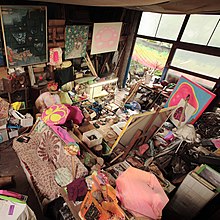Minoru Yoshida
Minoru Yoshida | |
|---|---|
| Born | 1935[1] Osaka[1] |
| Died | 2010 |
| Nationality | Japanese |
| Alma mater | Kyoto City University of Fine Arts[1] |
| Known for | Painting, Sculpture, & Performance Art |
| Movement | Gutai Art Association |
Minoru Yoshida (1935–2010) was a Japanese painter, sculptor, and performance artist, associated with the Gutai Art Association.
Early life and education
Yoshida attended a high school which specialized in science before studying painting at Kyoto City University of Fine Arts.[2]
He briefly ran a kimono-dyeing shop before beginning his professional career as an artist.[3]
Work

Yoshida is a second-generation Gutai artist, noted in the 1960s for his hard edge abstract paintings and futuristic sculptures before shifting the focus of his work to the performance format in the 1970s.[4] In 1965 he joined the Gutai movement.[3] Yoshida began incorporating performance art into his practice while living in New York City.[4] His performances often incorporated a "synthesizer jacket," a garment the artist created from plexiglass and adorned with circuits and resembling his earlier sculptures.[5] The artist also wired speakers into panels that were worn around the wearer’s thighs. By operating the different switches on the jacket, sculptural garment emitted a series of different rhythmic electronic sounds.[6] Yoshida lived in New York City from 1970 to 1978 before returning to Japan where he continued to work and perform until his death in 2010.[3]
Notable exhibitions
He was included in the 15th, 16th, 17th, 19th, 20th, and 21st Gutai Art Exhibitions at the Gutai Pinacotheca.[1] His piece Bisexual Flower was included in the Osaka World Expo 1970.[4] In 2013, Yoshida was included in Gutai: Splendid Playground exhibition at the Guggenheim Museum.[7]
Public collections
Yoshida's works can be found in the collections of Ashiya City Museum of Art and History, Hyogo, Japan; Ohara Museum of Art, Okayama, Japan; Takamatsu Municipal Museum, Kagawa, Japan; Niigata Prefectural Museum of Modern Art, Niigata, Japan; and National Museum of Modern Art,[8] Kyoto, Japan.[9][10]
References
- ^ a b c d "Minoru Yoshida: Waves of Light". ulteriorgallery.com. Retrieved 9 Jul 2023.
- ^ Horisaki-Christens, Nina (March 2019) [March], "When Video Promised a Sci-Fi Future", ArtAsiaPacific (112): 73–76
{{citation}}: CS1 maint: date and year (link) - ^ a b c "2 Art Gallery Shows to See Right Now". nytimes.com. Retrieved 9 Jul 2023.
- ^ a b c "Minoru Yoshida Performances in New York". realtokyo.co.jp. Retrieved 9 Jul 2023.
- ^ "Minoru Yoshida". artforum.com. Retrieved 9 Jul 2023.
- ^ "Minoru Yoshida: Performance in New York". brooklynrail.org. Retrieved 9 Jul 2023.
- ^ "Gutai: Splendid Playground". guggenheim.org. Retrieved 14 Jul 2023.
- ^ "Yoshida, Minoru". National Museum of Modern Art, Kyoto.
- ^ "Minoru Yoshida". Retrieved August 14, 2023.
- ^ "Minoru Yoshida: Paintings from 1960s". ArtWeek. Retrieved 14 August 2023.
